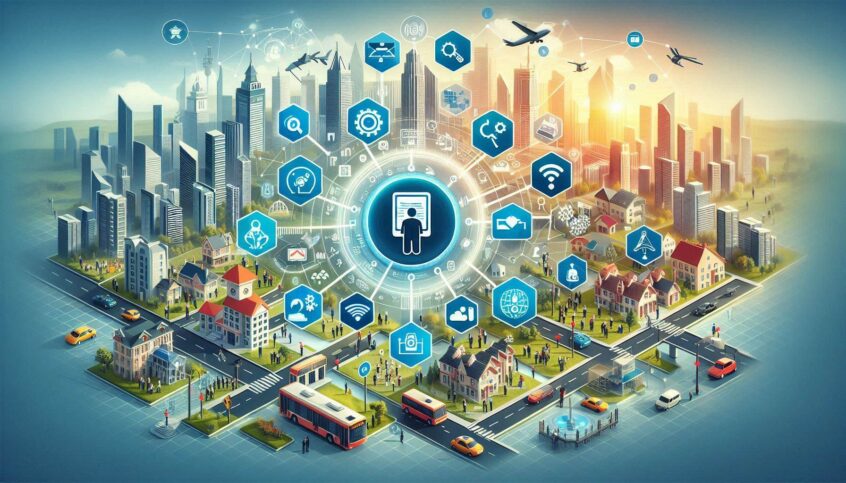Local government agencies increasingly use technology to improve their services, enhance communication, and increase efficiency. Limited budgets force leaders to review every line item and get creative on how best to stretch dollars. Ironically, while the budgets for cities, towns, and school districts remain stagnant (or outright shrink), citizen’s reliance on these agencies has increased in recent years.
So how are these agencies balancing budgets?
One key way local governments are staying “in the black,” is by strategically integrating technology. Here are some ways in which they utilize technology:
1. E-Government Services
- Online Portals: Local governments often provide online portals where citizens can access various services, such as paying bills (e.g., utilities, taxes), applying for permits, or registering for programs.
- Digital Forms and Applications: Residents can submit forms and applications online, reducing the need for in-person visits to government offices.
2. Communication and Public Engagement
- Social Media: Local governments use social media platforms (e.g., Twitter, Facebook, Instagram) to share information, engage with citizens, and provide real-time updates on issues like road closures or emergency situations.
- Email Newsletters and Alerts: These are used to keep residents informed about local news, events, and important announcements.
- Virtual Town Halls: Online platforms enable local governments to hold virtual meetings and town halls, allowing more residents to participate from home.
3. Data Management and Analytics
- GIS (Geographic Information Systems): GIS technology is used to map and analyze data related to land use, infrastructure, and environmental resources, helping with urban planning, emergency response, and resource management.
- Data Analytics: Local governments analyze data to improve service delivery, optimize resource allocation, and make informed policy decisions. For example, analyzing traffic data to improve transportation planning.
4. Smart City Initiatives
- IoT (Internet of Things): Sensors and connected devices are used to monitor and manage city infrastructure, such as streetlights, traffic signals, and waste management systems. This can lead to more efficient energy use and better traffic management.
- Smart Grids: These are used to manage electricity distribution more efficiently, reducing outages and optimizing energy consumption.
5. Public Safety and Emergency Response
- 911 Systems and Emergency Apps: Local governments use technology to enhance emergency response, such as through improved 911 dispatch systems or mobile apps that allow residents to report emergencies and receive alerts.
- CCTV and Surveillance: Technology is used to monitor public spaces, improving safety and helping law enforcement respond quickly to incidents.
6. Transparency and Open Data
- Open Data Portals: Many local governments provide access to public data through online platforms, promoting transparency and allowing citizens to explore information about government spending, crime statistics, and more.
- Budget Visualization Tools: These tools allow residents to see how public funds are being used, helping to build trust and accountability.
7. Digital Infrastructure and Connectivity
- Public Wi-Fi: Offering free or low-cost public Wi-Fi in parks, libraries, and other public spaces to increase digital access for residents.
- Broadband Initiatives: Local governments work to expand broadband access, particularly in underserved areas, to ensure that all residents have access to the internet.
8. Health and Social Services
- Telehealth Services: Local health departments may use technology to offer telehealth services, allowing residents to access healthcare remotely.
- Digital Platforms for Social Services: Residents can apply for and manage social services, such as housing assistance or food programs, online.
9. Sustainable Development and Environmental Monitoring
- Energy Management Systems: Technology is used to monitor and reduce energy consumption in public buildings, contributing to sustainability goals.
- Environmental Sensors: Sensors are deployed to monitor air and water quality, helping local governments to manage environmental health more effectively.
10. Transportation and Mobility
- Smart Traffic Management: Real-time traffic data and adaptive signal control systems are used to reduce congestion and improve traffic flow.
- Public Transportation Apps: These apps provide real-time updates on public transportation schedules and routes, making it easier for residents to plan their commutes.
11. Education and Libraries
- Digital Learning Platforms: Local governments support schools by implementing digital learning tools and platforms, especially during times when in-person education is disrupted.
- Online Library Services: Libraries offer e-books, online databases, and virtual programs, increasing access to resources.
12. Cybersecurity
- Protecting Data: As local governments collect and manage vast amounts of sensitive data, they invest in cybersecurity measures to protect against breaches and ensure the privacy of citizens’ information.
In summary, local governments use technology to enhance service delivery, improve communication, increase transparency, and build more efficient and sustainable communities. This technological integration is crucial for meeting the evolving needs of residents and managing the complexities of modern urban life. The list is long and highlights the need for technology support; a single IT employee can no longer maintain the entire IT infrastructure.
Technology touches every single department.
Technology is required for every transaction, every piece of communication, and every service.
State and federal governments have the advantage of scale when leveraging technology providers. These large government groups require so many licenses and services, they can negotiate better pricing than smaller government branches. These same state and federal agencies spend enough money with enterprise-size tech providers to receive top-notch customer service. Sadly, local governments don’t carry the same clout and often receive slow responses to questions and concerns or find their issues ignored altogether. As a result, more and more local governments are turning to local technology providers. A shared sense of community and knowledge of the unique physical, social, and economic environments results in a strong partnership.

